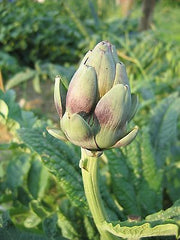Cynara Cardunculus, Cardoon, Artichoke Thistle
A very ornamental foliage plant and makes a very attractive feature in the garden. The leaves are long lasting in water and are often used in flower arrangements. At one time the cardoon was often grown for its edible stems.
The cardoon has become important as a medicinal herb in recent years following the discovery of cynarin.
The plant is said to yield a good yellow dye.
The dried flowers are a rennet substitute, used for curdling plant milks.
Prefers a light warm soil and an open position in full sun. For best results, this plant requires plenty of moisture in the growing season and a good rich soil, though another report says that it is drought tolerant once established. Tolerates most soils including heavy clays of both acid and alkaline nature, especially when grown in heavier or more spartan soils. Plants are reasonably wind resistant.
This species is hardy to about -10°c. Plants are more likely to require protection from winter cold when they are grown in a heavy soil. Wet winters can do more harm than cold ones.
Sow early spring in a greenhouse. Germination is usually quick and good, prick out the seedlings into individual pots as soon as they are large enough to handle and plant them out into their permanent positions during the summer. It would be prudent to give the plants some winter protection in their first year.
The seed can also be sown in situ in April. Sow the seed 2cm deep, putting 2 or 3 seeds at each point that you want a plant. Protect the seed from mice.
Edible uses
Flower buds - raw or cooked. A globe artichoke substitute. The flower buds are a bit smaller than the globe artichoke and so are even more fiddly to use. The buds are harvested just before the flowers open, they are then usually boiled before being eaten. Only the base of each bract is eaten, plus the 'heart' or base that the petals grow from. The flavour is mild and pleasant and is felt by some people to be more delicate than the globe artichoke.
Stems - cooked and used as a celery substitute. It is best to earth up the stems as they grow in order to blanch them and reduce their bitterness, these blanched stems can then be eaten cooked or in salads. In Italy raw strips of the stems are dipped into olive oil. We find these stems to be too bitter when eaten raw.
Young leaves - raw or cooked. Eaten as a salad by the ancient Romans. Rather bitter.
Root - cooked like parsnips. Tender, thick and fleshy, with an agreeable flavour.





